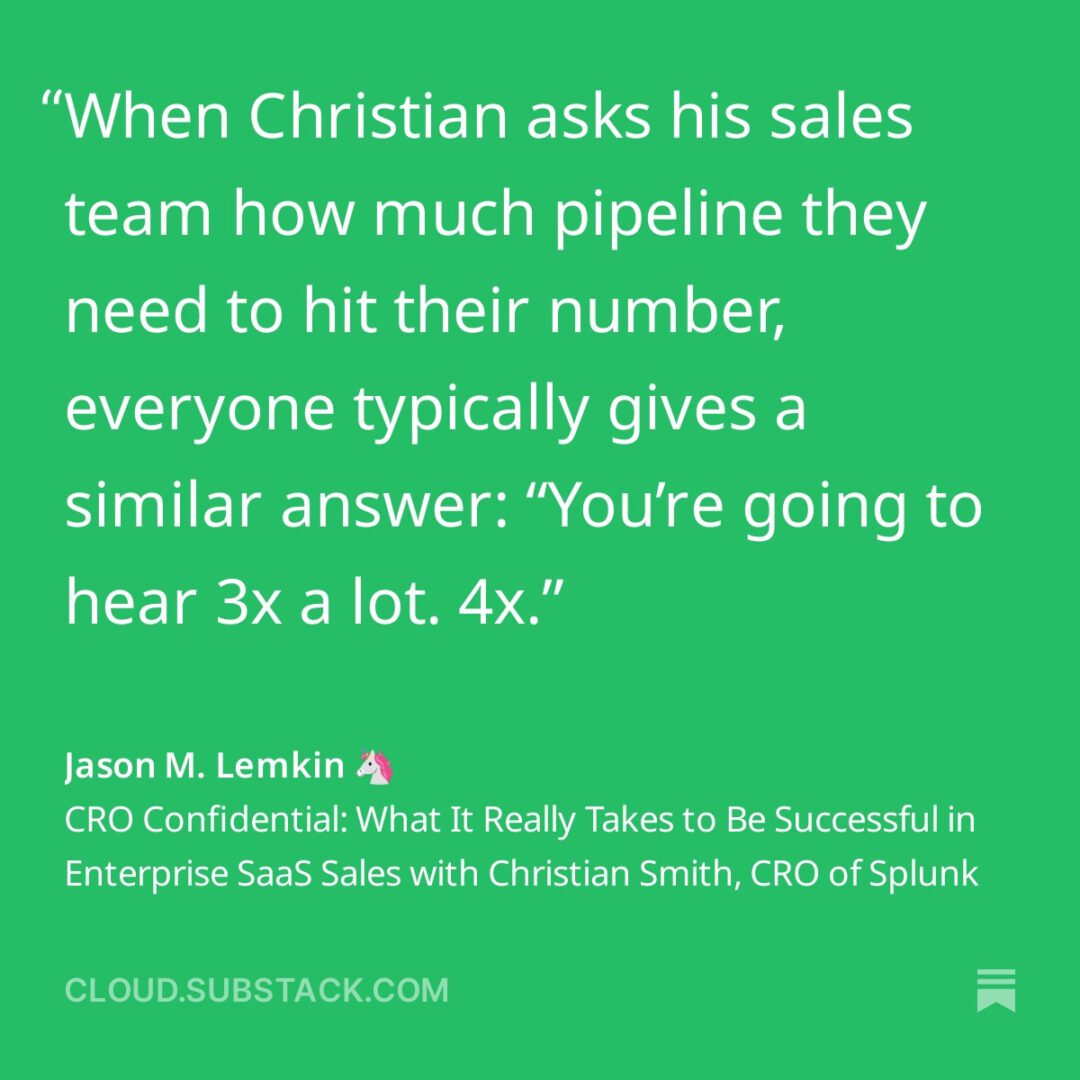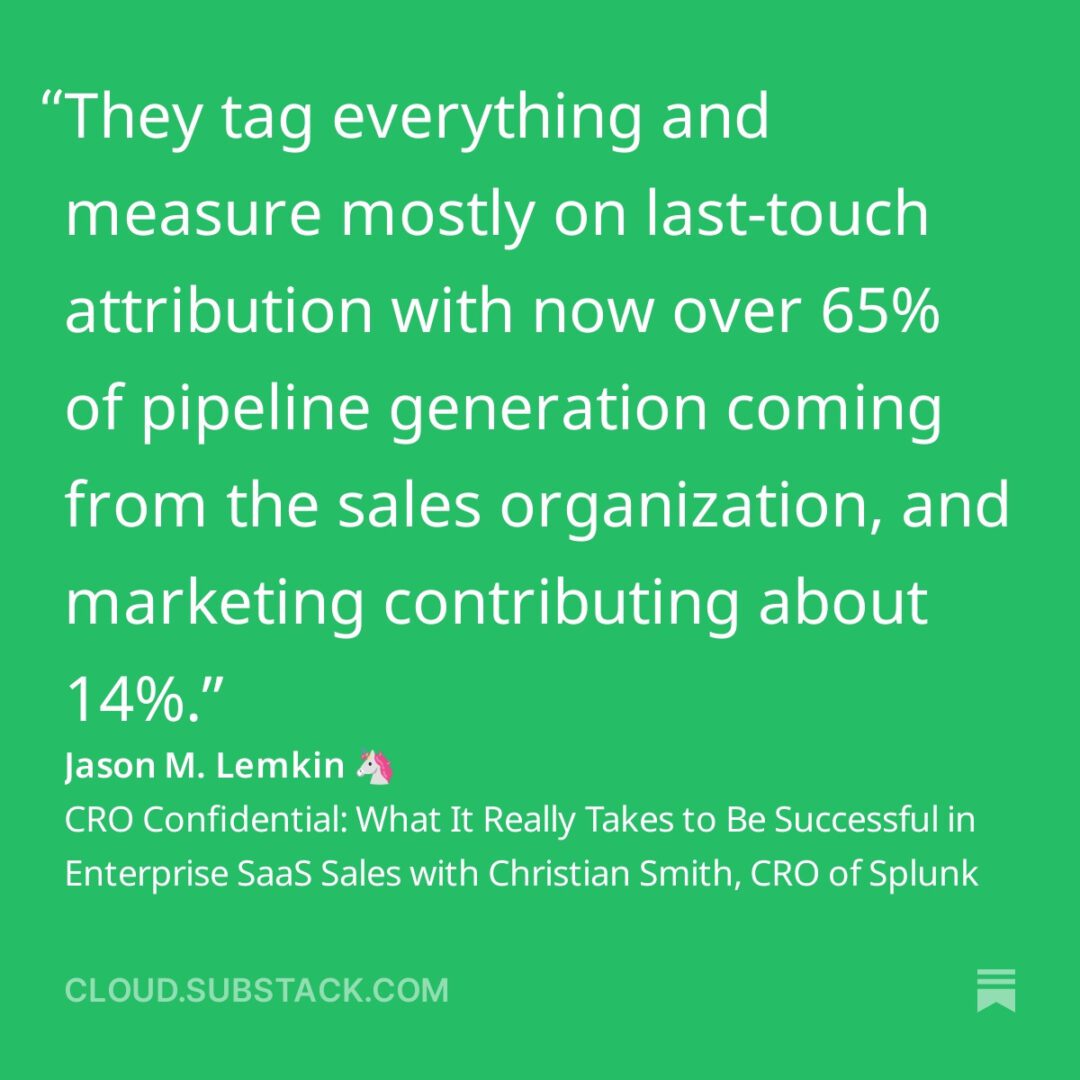In this week’s latest episode of CRO Confidential, Sam Blond, Partner at Founders Fund and former CRO at Brex, sits down with the CRO of Splunk, Christian Smith. Splunk is a 20-year-old Enterprise software giant that has accomplished many things — a 2012 IPO, a $28B+ Cisco acquisition in 2023, and $3.7 billion of ARR last year, with a market cap of $25.7 Billion.
Splunk’s core product is a platform for collecting and analyzing high volumes of machine-generated data. Over the years, Splunk has expanded its offerings through acquisitions and product development. As Christian shares on the pod, the company’s current customer list includes many notable companies, with 92 of them being on the Fortune 100. A feat!
As Christian’s been the CRO of Splunk for over seven years now, he’s a wealth of knowledge on what it really takes to be successful in Enterprise SaaS Sales.
Together with Sam, in today’s episode, they discuss everything Enterprise SaaS sales including:
- Pipeline health
- Enterprise pipeline generation
- How to create demand in the Enterprise when new business slows
- The pros and cons of a product-led pipeline
- And of course, Customer Success with Enterprise-level customers
The Metric that Determines the Overall Health of the Business
We started by level setting and asked Christian which metrics he goes to for assessing the overall health of the business. His answer? Pipeline, pipeline, and pipeline.
Where do you start, and which data cuts should you look at to assess the health of your pipeline? Analyzing pipeline takes a lot of work, data, and pattern discovery, and sometimes, early companies don’t have a lot of information to work with. But once you can establish a way to repeatable measure pipeline, there are three rules Christian recommends and follows when assessing pipeline health:
- Check all of your biases at the door
- Measure everything
- Think of pipeline as a village activity

The first rule: Check Your Biases at the Door. When Christian asks his sales team how much pipeline they need to hit their number, everyone typically gives a similar answer: “You’re going to hear 3x a lot. 4x. Generally, there’s no math or science behind what they’re saying. They’re just using whatever their biases are. So check your biases, because you don’t know yet.” In essence – re-train your sales team to think about pipeline requirements based on actual data vs. gut instinct.
The second rule: Measure Everything. Measure everything because the more you measure, the more data slices you can create. You’ll need those data slices at different times. Fundamentally, you need to know how much pipeline you have at every point in time, in what stages, and from what sources. “Measure everything you possibly can,” Christian recommends. “Capture it and keep it because a whole bunch of the science behind pipeline is measuring at a specific point in time and comparing and contrasting so you can identify what’s changing and what’s not.”
The third rule: Think of Pipeline as a Village Activity. No one person or sales rep owns a piece of the pipeline. The entire team owns the entire pipeline. It can be the hardest thing in a CRO’s career to get everyone to agree to be ruthlessly transparent about the state and health of the pipeline and which pipeline matters.
Christian explains, “The big aha is figuring out it’s not about the pipeline. It’s about the quality of the pipeline. It’s about what pipeline actually converts and what are the characteristics of that pipeline and how do we do more of that? And less of the other things. And I’m sure we’ve all seen this where we’ve been in pipeline meetings where you have a particular person who will stand up and be clapping about their incredible green (pipeline) results for the quarter. And meanwhile, you’ve completely missed the sales number. Those two things should not exist in the same company.”
Quality pipeline is more effective and important than just quantity or vanity pipeline that just all ends up in closed lost. Ruthless transparency in sales can certainly be challenging to develop since most sales reps like to perform against a metric they can control and feel good about. But as a company, if you can understand the dynamics that matter and how to do more of the right things, you’ll go far. So, measure everything and then start slicing the data where it matters most.
Who Should be Responsible for Pipeline? Marketing or Sales?
Folks often think of marketing as the primary department responsible for pipeline generation. But in reality, especially as you move upmarket – everyone should be responsible. The Splunk team has matured away from thinking about pipeline generation as a silo. Early in their growth, they thought the primary responsibility for pipe generation fell with marketing, sales, and partners.

Today, as they’ve matured, Christian and the Splunk team now look at every influence point in the pipeline. They tag everything and measure mostly on last-touch attribution with now over 65% of pipeline generation coming from the sales organization, and marketing contributing about 14%.
Why is that?
Well for Splunk, creating demand as an Enterprise business requires entirely different motions above and beyond just your standard ebooks, whitepapers, and events. They also understand and acknowledge any opportunity at this level and stage has on average interacted with 150 different touchpoints in the organization to get there — podcasts, downloaded white papers, etc. Hence, Christian’s firm belief that everyone should be responsible for generating and influencing pipeline. This isn’t just a bifurcation between marketing owning all pipe and sales just owning conversion.
As you move down to the individual contributors, salespeople are responsible for closing business and generating their own pipeline.
When Pipeline Isn’t What You Want it to Be
To understand your pipeline health, you really need to understand its dynamics. If pipeline isn’t where it needs to be to sustain growth, you should see it coming because the data shows you that what you’re generating isn’t keeping pace with where you want to go.
Christian recommends you to do a few things to course correct:
- Determine what you can do to drive close rates up based on the dynamics of the pipeline
- Determine how big of a gap and problem there is and go to the village to determine what’s working and not working.
The worst thing you could do is double down on activities that are creating an ineffective pipeline that’s not ultimately closing. Instead, don’t panic. Focus on quality.
There is a spectrum in pipeline, a tradeoff between quantity and quality. In the early days, the constraint to growing faster is on the quantity side. Startups don’t have sophisticated data about how customers perform over long periods of time, conversion rates, etc.
In the early days, it’s about getting as much pipeline as possible. In that environment, the most effective thing is understanding the business and mapping existing resources that you have, whether it be in the form of marketing, sales, SDR, and more.
Over time, quality becomes a priority with a more mature business. Eventually, you have the data and pattern-matching in the existing book to focus a lot of resources on generating a specific type of opportunity rather than a large volume of opportunities.
Splunk’s Favorite Demand Gen Strategy
Christian thinks the most underinvested area is product-generated pipeline. Specifically, once a customer is in your product, even as a trial and certainly as an existing customer, your product experience has a unique opportunity to put new capabilities and offerings right in front of the customer in their workflow to drive value.
If you can master that, you’re creating the best pipe possible.
Another version of tapping into the existing customer base is in the product. You can generate additional pipeline for expansion opportunities within your base. You can also generate new demand from non-customers, leveraging your customer base to be advocates for your product and business.
This is an area where many places focus too little effort and resources. Many get it right early in the trial experience, but you need to figure out how to keep that customer building more pipeline with you.
Team Structure within an Enterprise Sales Organization Like Splunk
Over the last two years, more VC-backed tech companies have been moving upmarket. The benefits are chunkier revenue and stickier, and investors highly value it. Thinking about an Enterprise poster child like Splunk, let’s look at the team structure in terms of inside vs. hybrid vs. dedicated field sales roles.
For an Enterprise-grade offering, the motions match your product. The funny thing with investors is they want to go up Enterprise, but their product isn’t designed that way. Splunk was designed to solve a pretty complex set of problems and found that segmentation is critical and keeps evolving.
You have to keep thinking about segmentation and refining it over time. Splunk has a multi-tiered segmentation approach.
- The key accounts, their largest spenders, and largest potential are typically set up with a patch of 1-3 accounts per seller.
- As they move down to the classic Enterprise market, those reps typically have ten accounts each.
- Following that, you have emerging Enterprise and the lower spend, which may have 30-60 accounts per rep.
- Everything else is scale, which may be commercial, partnered motions, and inside sales driving and assisting those partners.
All segmentation is done by ARR and ARR potential, so even if it’s a global 100 account, if they’re spending nothing with Splunk, they’ll be in an Enterprise segment, but with a very different motion than if they’re spending $15M-$20M.
Meeting In Person vs. Remote
At Brex, they measured meeting people in person vs. not meeting them. The conversion rate difference was 3x when meeting people face-to-face. As you move upmarket, you unnecessarily penalize yourself by not spending time in front of customers.
In 2020, no one was meeting in person. Now, we’re long past restrictions, yet many haven’t returned to the office daily. Pre-pandemic, Splunk’s selling methodology was to be on-site, walking the halls, influencing multiple champions, discovering use cases in real-time, and building demand from inside.
Of course, post-pandemic, they got very good at selling virtually. They were always hybrid, though.
Today, they’re traveling a lot more than during the pandemic and a lot less than before. They’re leveraging virtualization even more because they match where their customers are.
How do you balance this? By putting the customer at the center of everything you do. What do they want from the experience? How do you help them through the buying cycle?
Some want to be highly virtual, and others are a combination. But the truth is it’s much harder to build a deeper relationship with someone remotely. In Splunk’s type of selling, they’re trying to build long-term relationships with customers and drive most revenue through the install base.
If you can meet with customers face-to-face more often, you’ll have a real competitive advantage because many organizations haven’t course-corrected back to how they should be, especially in an Enterprise-selling environment.

